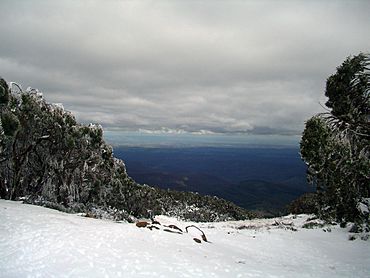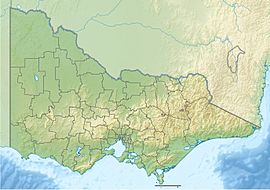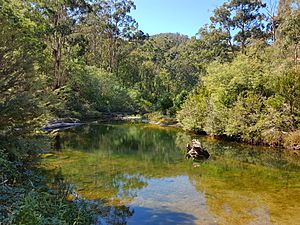Baw Baw National Park facts for kids
Quick facts for kids Baw Baw National ParkVictoria |
|
|---|---|
|
IUCN Category II (National Park)
|
|

|
|
| Nearest town or city | Rawson |
| Established | April 1979 |
| Area | 135.3 km2 (52.2 sq mi) |
| Managing authorities | Parks Victoria |
| Website | Baw Baw National Park |
| See also | Protected areas of Victoria |
The Baw Baw National Park is a special natural area in Victoria, Australia. It's found where the Central Highlands and Gippsland regions meet. This huge park covers about 13,530-hectare (33,400-acre) (over 33,000 acres!). It's about 120 kilometres (75 mi) east of Melbourne and 50 kilometres (31 mi) north of the Latrobe Valley.
The park includes the Baw-Baw Plateau and is right next to the Mount Baw Baw Alpine Resort. The Baw-Baw Plateau is a high, flat area with several peaks. These peaks include Mount Baw Baw, Mount St Gwinear, Mount St Phillack, Mount Erica, and Mount Whitelaw.
These areas are mostly subalpine, meaning they are just below the treeline. You'll see weathered granite boulders and alpine meadows. These meadows are dotted with snow-gum trees. A lot of the park's slopes collect water for the Thomson River and the Thomson Reservoir. They also feed the Tanjil and Tyers rivers.
Contents
Park History: When Was Baw Baw National Park Created?
The land around Baw Baw National Park has a long history. The Wurundjeri people of the Kulin Nation are the traditional owners of this land. The Gunaikurnai people also see Baw Baw National Park as their traditional country.
Europeans first explored this area in 1860. A botanist named Ferdinand von Mueller led this exploration. People started settling here in the 1880s and 1890s. This happened after gold was discovered in the area.
Baw Baw National Park was officially created in April 1979. Later, on November 7, 2008, it was added to the Australian National Heritage List. It's part of a group of eleven areas called the Australian Alps National Parks and Reserves. Baw Baw National Park is special because it's the most southern sub-alpine area on mainland Australia.
Nature and Wildlife: What Animals Live Here?
The plants in the park are typical for a sub-alpine area. You'll find low-lying grasses, heathlands, and snow gums.
The park is home to many animals, especially in the lower areas. One very special animal is the Leadbeater's possum. This possum is highly endangered and is Victoria's state animal emblem. Another important animal is the Baw Baw frog (Philoria frosti). This frog is critically endangered and only lives in this region.
You might also spot the Baw Baw berry (Wittsteinia vacciniacea). This plant loses its leaves in autumn and can be found on the plateau.
Park Name: What Does Baw Baw Mean?
The national park gets its name from Mount Baw Baw. In the Aboriginal Woiwurrung language, the mountain's name might have been bo-ye, meaning "ghost." Or it could have been bo-bo, meaning bandicoot.
In the Bunurong language, the mountain was thought to be named Bore Bore. In the Gunai language, it was called Bo Bo. Both of these names mean "echo."
Fun Activities: What Can You Do at Baw Baw?
Baw Baw National Park is a great place for outdoor adventures. In winter, it's popular for skiing. In summer, many people enjoy bushwalking.
Here are some popular activities:
- Cross-country skiing
- Downhill skiing
- Summer bushwalking
- Rafting and canoeing
- Fishing
- Scenic drives
- Picnics
The Australian Alps Walking Track goes right through the park. This long walking track starts at Walhalla and heads north. The section through Baw Baw takes less than three days to walk. It offers amazing views for those who love plants or rocks.
The highest point in the park is Mount St Phillack. This granite plateau stands tall at 1,566 metres (5,138 ft).
Ski touring is also popular along the Baw Baw Plateau. You can ski between Mount Baw Baw, past Mount St Phillack, to Mount St Gwinear. A group of volunteers helps patrol the St Gwinear area on weekends. They access the park from the opposite side of the plateau from the ski resort.
Nordic skiing (cross-country skiing) was introduced at Mount Baw Baw in 1972. There are championship races and a ski school for those who want to learn.
See also
 In Spanish: Parque nacional Baw Baw para niños
In Spanish: Parque nacional Baw Baw para niños



